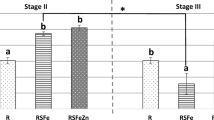Abstract
The utilization of selected minerals when sugars were supplemented to basal diets was investigated in two separate, laboratory-controlled human feeding studies. Fructose-fed subjects had higher fecal excretions of iron and magnesium than did subjects fed sucrose. Apparent iron, magnesium, calcium, and zinc balances tended to be less positive during the fructose feeding period as compared to balances during the sucrose feeding period. Conversely, high fructose corn syrup (HFCS) did not affect the mineral balances when compared to sucrose feeding. Subjects fed fructose experienced diarrhea which possibly decreased absorption of minerals and thus increased fecal mineral losses. No such adverse effects were noticed when HFCS was fed.
Similar content being viewed by others
References
Carmen HF, Thor PK (1979) High fructose corn syrup: economic aspects of a sugar substitute. Davis, University of California: 20–34
Brook EM (1977) High fructose corn syrup: its significance as a sugar substitute and its impact on the sugar. The World Bank Commodity Paper 25. Washington DC World Band: 2–21
Cardillo AV, Hunt D, Mann B (1979) Relative sweetness of fructose and sucrose in model solutions, lemon beverages, and white cake. J Food Sci 44: 748–751
Hodgkinson RA (1961) A comparative study of iron absorption and utilization following ferrous sulphate and sodium irondetate. Med J Australia 48: 809–813
Reiser S, Ferretti RJ, Fields M, Smith N (1983) Role of dietary fructose in the enhancement of mortality and biochemical changes associated with copper deficiency in rats. Am J Clin Nutr 38: 214–222
Meyer FL, Copper K, Bolick M (1972) Nitrogen and mineral excretion after carbohydrate test meals. Amer J Clin Nutr 25: 667–683
Scholz RW, Featherston WK (1967) Influece of lactose and glucose on magnesium-28 retention in the chick. J Nutr 91: 232–236
Entringer RP, Plumlee MP, Conrad JH, Cline TR, Wolfe S (1975) Influence of diet on passage rate and apparent digestibility by growing swine. J Anim Sci 40: 486–494
Wilson GF, Reid CSW, Malloy LF, Metson AJ, Butler GW (1969) Grass tetany: influence of starch and peanut oil supplements on plasma magnesium, calcium and phosphorus levels in grazing dairy cows. New Zealand J Agri Res 12: 467–472
Bates GWJ, Boyer J, Hegenaver JC, Saltman P (1972) Facilitation of iron absorption by ferric fructose. Am J Clin Nutr 25: 983–986
Folin O (1914) On the determination of creatinine and creatine in urine. J Biol Chem 17: 469
Fiske CH, Subbarow A (1925) The colorimetric determination of phosphorus. J Biol Chem 66: 375–400
Author information
Authors and Affiliations
Rights and permissions
About this article
Cite this article
Ivaturi, R., Kies, C. Mineral balances in humans as affected by fructose, high fructose corn syrup and sucrose. Plant Food Hum Nutr 42, 143–151 (1992). https://doi.org/10.1007/BF02196467
Received:
Accepted:
Issue Date:
DOI: https://doi.org/10.1007/BF02196467




